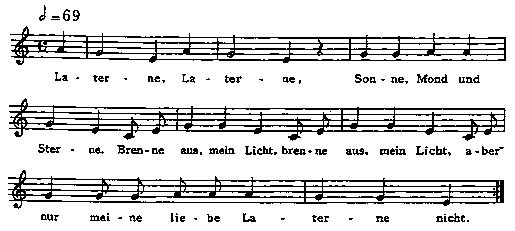Folk & Traditional Music of the Western Continents
The folk & traditional music of Europe, Africa & the Americas explored.
| Share page | Visit Us On FB |
|
THE GERMANIC PEOPLES 71 |
||
|
|
||
|
and has melodies making liberal use of triads with implied harmony. Tempi and meters are even and constant, and the singing style is definitely tempo-giusto. There is also a later layer of song, that of the German broadside ballads, mainly from the nineteenth century. Here the style is that of nineteenth-century popular music, with some chromaticism, modulation, instrumental accompaniment, and what we today feel is a sentimental quality.
A children's song still widely used is shown in Example 4-9. It is sung in autumn by children while walking in pairs or small groups, carrying lanterns. The structure, which consists essentially of one |
||
|
|
||
 |
||
|
|
||
|
example 4-9. German children's song, "Laterne, Laterne," from pamphlet accompanying the recording, Deutsche Volkslieder, eine Dokmnentation des Deutschen Musikrates, ed. Deutsches Volksliedarchiv, Freiburg (Wol-fenbuttel: Moseler Verlag, 1961), p. 19. |
||
|
|
||
|
line repeated with variations, is typical of children's songs throughout Europe and may, historically, represent an archaic layer of style that preceded the various national folk styles, which are evidently mainly of medieval origin. Especially typical is the scale, which is tetratonic, but which emphasizes the tones, E, G, and A. The added C in Example 4-9 may be interpreted as a result of the importance of the triad in German folk song style.
Polyphonic singing is not common in the Germanic-speaking nations, except for Germany, Austria, and Switzerland. Canons are found throughout Europe, but another characteristic form of polyph- |
||